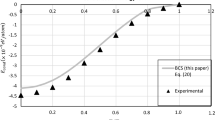Abstract—It is shown that if the temperature of the second-order phase transition is lowered due to fluctuations, then the dominant singularity at the transition is the maximum, and not the jump in specific heat. A certain value of latent heat corresponds to this transition, and an estimate is proposed for it. The result is compared with the singularities of the specific heat and coefficient of thermal expansion in the region of Peierls and superconducting transitions.


Similar content being viewed by others
Notes
J.W. Brill 2004, private communication.
Below we discuss the temperature dependences of H and cp. It is understood that the same is true for quantities Lx, y, z and α.
The idea of retaining the area under the curve α(T) was used in [8] to estimate TMF in the case of underdoped YBa2Cu3Ox.
REFERENCES
L. D. Landau and E. M. Lifshits, Statistical Physics (Nauka, Moscow, 1964, 1976; Pergamon, London, 1969).
K. H. Mueller, F. Pobell, and Guenter Ahlers, Phys. Rev. Lett. 34, 513 (1975).
V. Pasler, P. Schweiss, C. Meingast, et al., Phys. Rev. Lett. 81, 1094 (1998).
P. A. Lee, T. M. Rice, and P. W. Anderson, Phys. Rev. Lett. 31, 462 (1973).
M. E. Itkis and F. Ya. Nad’, Pis’ma Zh. Tekh. Fiz. 39, 373 (1984).
B. P. Gorshunov, A. A. Volkov, G. V. Kozlov, et al., Phys. Rev. Lett. 73, 308 (1994).
V. Ya. Pokrovskii, S. V. Zaitsev-Zotov, and P. Monceau, Phys. Rev. B 55 (13), R13377 (1997).
C. Meingast, V. Pasler, P. Nagel, et al., Phys. Rev. Lett. 86, 1606 (2001).
M. R. Hauser, B. B. Plapp, and G. Mozurkevich, Phys. Rev. B 43, 8105 (1991).
J. W. Brill, M. Chung, Y.-K. Kuo, et al., Phys. Rev. Lett. 74, 1182 (1995).
L. Onsager, Phys. Rev. 65 (3-4), 117 (1944).
C. Meingast, A. Junod, and E. Walker, Physica C 272 (1), 106 (1996).
M. Chung, Y. -K. Kuo, X. Zhan, et al., Synth. Met. 71 (1–3), 1891 (1995).
D. Staresinic, A. Kiš, K. Bilacović, et al., Eur. Phys. J. B 29 (1), 71 (2002).
J. E. Lorenzo, R. Currat, P. Monceau, et al., J. Phys. Cond. Mat. 10 (23), 5039 (1998).
V. Ya. Pokrovskii, A. V. Golovnya, and S. V. Zaitsev-Zotov, Phys. Rev. B 70, 113106 (2004).
A. P. Levanyuk, Zh. Eksp. Teor. Fiz. 36, 810 (1959).
V. L. Ginzburg, Fiz. Tverd. Tela (Leningrad) 2, 2031 (1960).
Z. Y. Chen, P. C. Albright, and J. V. Sengers, Phys. Rev. A 41, 3161 (1990).
G. Mozurkewich, M. B. Salamon, and S. E. Inderhees, Phys. Rev. B 46, 11914 (1992).
Funding
The work was supported by the Russian Science Foundation, project no. 17-12-01519.
Author information
Authors and Affiliations
Corresponding author
Rights and permissions
About this article
Cite this article
Pokrovskii, V.Y. Distributed Latent Heat of Phase Transitions in Low-Dimensional Conductors. J. Commun. Technol. Electron. 65, 1204–1207 (2020). https://doi.org/10.1134/S1064226920090089
Received:
Revised:
Accepted:
Published:
Issue Date:
DOI: https://doi.org/10.1134/S1064226920090089




